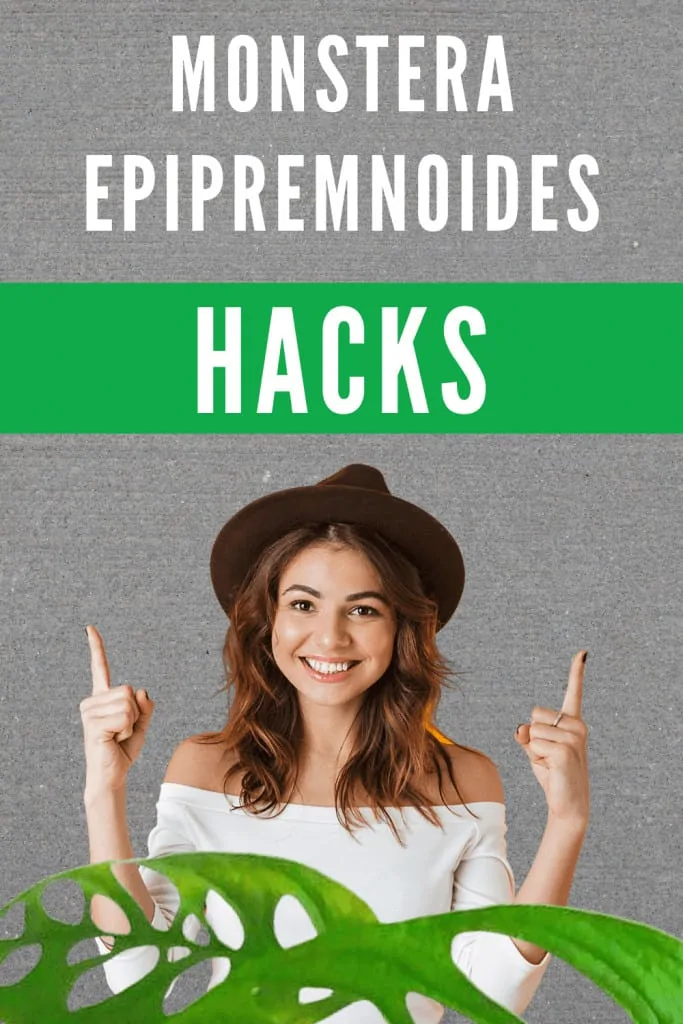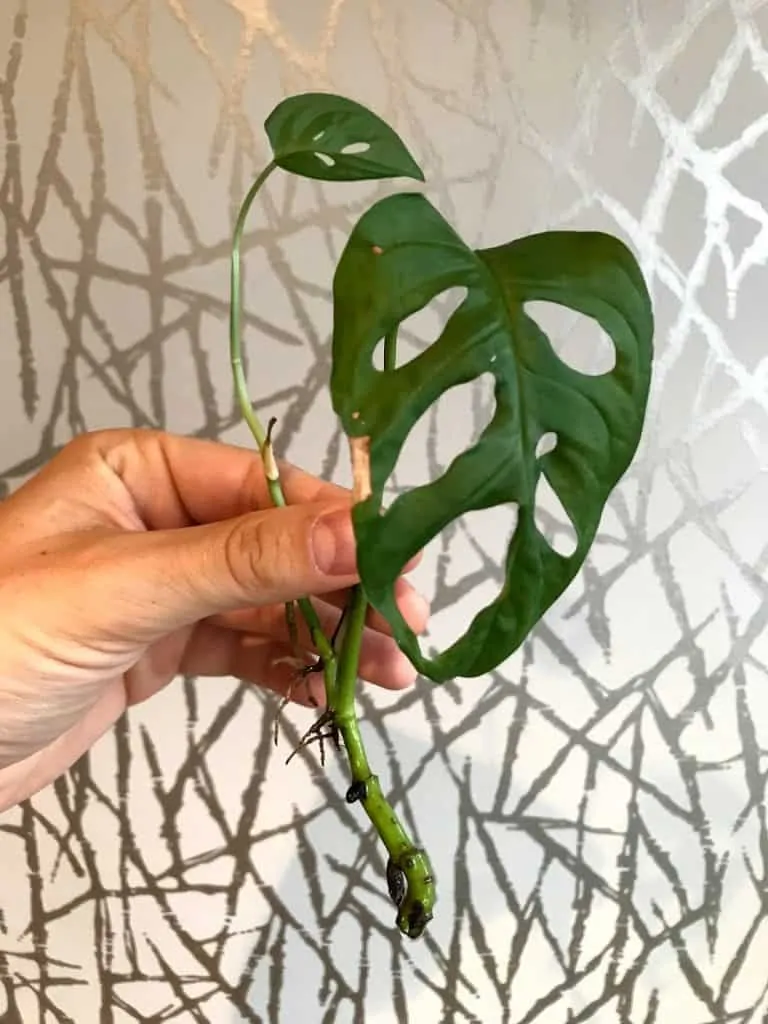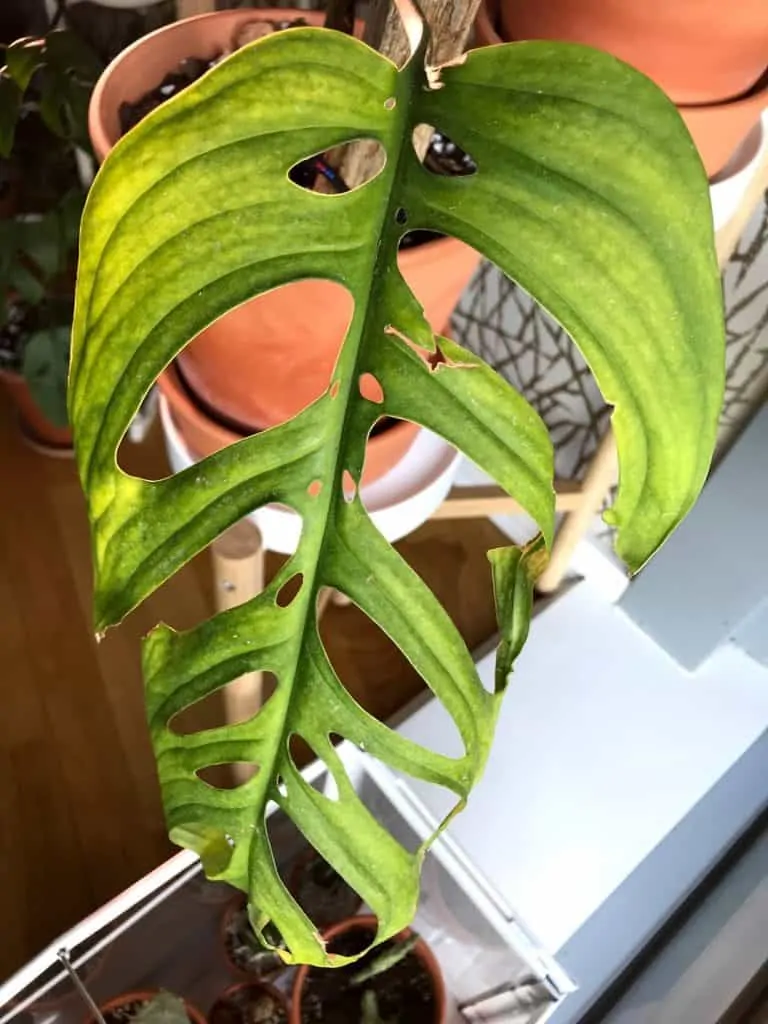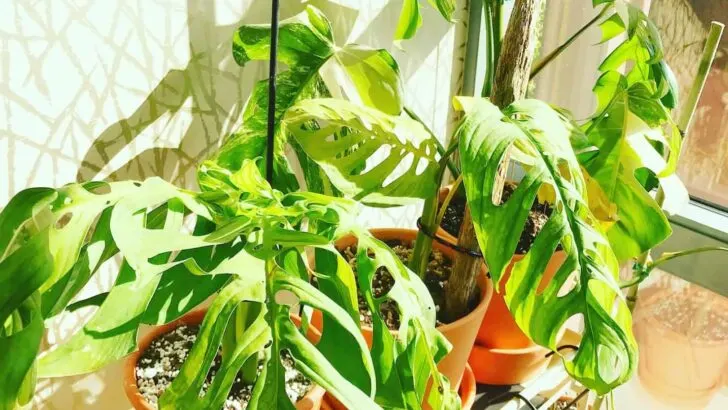Let’s talk about Monstera Epipremnoides or Monstera Esqueleto as it is called nowadays.
It is the bigger brother of the Monstera Adansonii as its leaf size is quite a bit bigger than the regular Monstera Adansonii but just as holey.
It belongs to the same family called Aracea, the arum family.
Monstera Epipremnoides is a flowering evergreen and a distinctive characteristic of aroids is the inflorescence or flower called spadix that is often covered by a spathe.
Monstera Epipremnoides Care
Monstera Epipremnoides care requires well-draining soil. Use soil consisting of bark, perlite, coco coir, charcoal, and some potting mix. It grows well in bright indirect light in an east, west, or north-facing window. Water once a week and keep the soil slightly humid but never soggy. Keep temperatures between 64°F – 80°F ( 18°C – 27°C). Keep humidity at 60% or more if possible. Use a diluted houseplant fertilizer at half-strength 3 times a year in spring and summer.

Monstera Epipremnoides Care
Table of Contents
When we are talking about Epipremnoides we have to say it is most likely that we are not actually talking about Monstera Epipremnoides as the plant that has been claimed for years to be it, actually isn’t.
If you want to believe Mick Mittermeier, an aroid enthusiast who has seen the real plant in situ, he says that he always doubted the plant grown in South East Asia and sold as Monstera Epipremnoides is the real deal.
It seems to look like another case of #itsneverobliqua or in this case #itsnevermonsteraepipremonides.
We should therefore probably be talking about a Monstera NOID or unidentified species.
The plant I am going to write about here is now known as Monstera Esqueleto.
However, as everyone that is is looking for the plant knows it by this name, I will stick with Monstera Epipremnoides during this article.
Let’s have a closer look at what Monstera Epipremnoides care involves in terms of watering, soil, humidity, temperature as well as propagation:
Monstera Epipremnoides Care Guide
Soil
Use a well-draining soil mix. Monstera Epipremnoides does not like to stay in soggy soil. This will lead to root rot very fast. A good aroid soil mix is best.
A proper soil mix for aroids usually consists of pine bark, perlite, coco coir, charcoal. and some parts of a good potting mix.
Use twice the amount of pine bark versus the other soil mixture ingredients as the chunky pine bark helps to aerate the soil.
Epipremnoides like airy soil that can be kept slightly moist if you have a chunky mix.
Light
Monstera Epipremnoides prefers bright indirect light.
In nature, Monstera Epipremnoides gets dappled sunlight through the rainforest canopy. Can take direct sunlight but make sure that it gets a maximum of 2-6 hours as anything more might burn the leaves.
An east-facing window is best where your houseplant gets a couple of direct sunlight in the morning when the sun isn’t too strong.
Watering
Water about once a week and make sure that the soil is just slightly damp before you water again.
If the soil is still very wet and damp do not water as soggy soil for an extended time leads to root rot.
When watering water thoroughly and make sure that the water is flowing through the soil mixture and that a big part is coming out of the pot immediately.
That is a good indicator that the soil is well-draining enough.
Temperature
Monstera Epipremnoides can be grown outdoors in USDA hardiness zones from 9b -11. Temperatures should be kept between 64°F – 80°F ( 18°C – 27°C). They sometimes grow in mild to cold temperatures in nature as they are found in high elevations.
Humidity
High humidity is important for all Monsteras.
Monstera Epipremnoids grows best in humidity levels between 80-100%.
A humidity level above 60% is already great although it will tolerate lower humidity levels.
The Monstera Epipremnoides is no exception. Use a humidifier, a pebble tray below the plant pot.
An alternative way as always is to keep multiple houseplants closely together to allow for a humid microclimate.
I prefer to use a humidifier.
Fertilizer
Fertilize sparingly.
I have a specimen that showed signs of fertilizer burn just by using a slow-release fertilizer.
I recommend using a diluted fertilizer 3-times a year and applying it well away from the base of the plant.
Propagation
Monstera Epipremonides is propagated from stem cuttings. You will need at least one node and part of a stem to propagate. A stem with a node and no leaves is possible to propagate but it will take a long time.
It is best to take a cutting with 1-3 leaves and at least one node.
Growth
It is a slow grower from our point of view that produces about a leaf a month in indoor growing conditions. But the leaves are massive and look amazing and are well worth the wait.
As Monstera Adansonii and Monstera Deliciosa, Monstera Epipremnoides is a climber and will appreciate a totem or moss pole where it will attach to with its aerial roots eventually.
Potting
A pot with holes at the bottom is best to allow for sufficient drainage.
From our experience, using clay pots did not work so well as these plants need most soil and the clay pots are drying out the substrate too quickly through the porous material they are made of.
We are now using plastic pots with drainage holes and they seem to work great so far as they keep the humidity in the soil for an extended time.
How to propagate Monstera Epipremnoides
There are three main ways to propagate this plant. The first option is to root the cutting in water, the second option is to use sphagnum moss whereas the third option is to use moist soil.
Let’s get started with the option number, which is putting your Monstera Epipremnoides cutting directly into the water. The best way is to make sure that your water is as clean as possible, is by using reverse osmosis water or distilled water.
However regular tap water will just be fine although there is a chance that it is containing pathogens and chemicals that might not optimal when rooting cuttings in water.
The second option is to use sphagnum moss to root your cutting. When using sphagnum moss, make sure that it is slightly wet and not completely soaked with water as this might rot your cutting.
The best way to ensure that you are using sphagnum moss with the right humidity is by first soaking it in water and then pressing it in your fist and couple of times.
This way you will achieve that the moss will be just slightly moist but not completely soaked anymore.
Depending on the container you’re keeping your moss, you need to make sure every couple of days that it stays slightly moist and is not completely drying out.
The third option we have mentioned is to put your cutting directly into moist soil. This is from our point of view the easiest option but also the hardest as you cannot see your cutting and you will not see whether roots are forming or not.
After a couple of weeks, you can gently pull on your cutting and in case of resistance you have a good indicator that roots have started to form.
There is also a fourth method that is not commonly used. It is to root your cutting entirely in perlite. Perlite is a volcanic substance that does not contain any pathogens and is pH neutral.
The chance of root rot is less likely and also it’s also unlikely that your cutting will rot. A further advantage is that perlite is porous and consists of small light rocks. This ensures good aeration and makes sure that when roots form they will have sufficient O2.
Monstera Epipremnoides vs Monstera Adansonii
Let’s now talk about the differences between Monstera Adansonii and Monstera Epipremnoides.
A lot of people are trying to tell the difference between the two and are asking on Facebook and also Instagram if the plant they have is a Monstera Adansonii or a Monstera Epipremnoides. Some people even tend to bring in the Monstera Obliqua and are entirely confused.

Monstera Adansonii leaf. The leaf has a dark green color.

Monstera Epipremnoides leaf. You can clearly see the light green colour and you can guess the thickness and texture of the leaf by just looking at it.
The best thing to tell Aroids apart is always to have a look at the inflorescence and therefore look at the spathe and the spadix that are components of it.
The problem with the inflorescence is that she is mostly not present and can only be seen on mature plants. We, therefore, list several differences from our point of view that help to differentiate the two.
A big difference from our point of view is how leathery the leaves of Monstera Epipremnoides are. They are quite thick and if you touch them you have this leathery hairy feeling as you would touch leather.
Another difference from our point of view is the colour of the leaves. Both Monstera types have green leaves but the leaves of Monstera Epipremnoides happen to be a much lighter and shinier green compared to the dark green foliage of a Monstera Adansonii.
Lets of course talk about the holes in the leaves. Monstera Adansonii has a huge variance in how the leaves look like from just a few holes to very perforated depending on the sub-type of Adansonii you have.
However, when looking at the Monstera Epipremnoides you can see that the holes start in the middle of the rib and are almost extending to the edge of the leaves and are sometimes even separating the leaf and thus give it a pinnatifid look.
This is mostly not the case on Monstera Adansonii.
Last but not least there is a difference in the size of the leaves. Epipremnoides is said to throw out huge leaves even from quite a young age and they are just continuing to grow bigger whereas the Monstera Adansonii leaves are quite small in the juvenile plant and are growing bigger over time.
In all fairness, Monstera Adansonii leaves can also grow huge but never as tall as the Epipremoides. Epipremnoides is said to grow leaves between 14 inches to 22 inches long (35cm-55cm) according to aroid.org and Michael Madisons A Revision of Monstera (Araceae).
Frequently Asked Questions About Monstera Epipremnoides
What is the difference between Monstera Adansonii and Monstera Epipremnoides?
The biggest differences are the leaf size, the colour of the leaves and the perforations. Monstera Epipremnoides has bigger leaves, lighter green coloured leaves with a leathery texture and perforations that start on the midrib and reach almost or even entirely to the edge of the leaves.
How much does a Monstera Epipremnoides cost?
Depending on where you live prices may vary greatly. But as the Monstera Epipremnoides is quite rare and hard to get, the prices range between $100 – $200 dollars for a plant.
Is Monstera Epipremnoides a rare plant?
Monstera Epipremnoides is still considered a rare plant. Buying one will set you back a couple of $100s and it is still not widely available.
Why do some people call the former Monstera Epipremnoides now Monstera NOID?
Mick Mitty an aroid enthusiast has seen what he believes to be the real Monstera Epipremnoides and therefore claims that the one in cultivation should no longer be called that name. Things like this where plants are not identified or have to be renamed are happening all the time. The correct way to refer to the former Monstera Epipremnoides is now to just say Monstera NOID as it is not identified.

Daniel has been a plant enthusiast for over 20 years. He owns hundreds of houseplants and prepares for the chili growing seasons yearly with great anticipation. His favorite plants are plant species in the Araceae family, such as Monstera, Philodendron, and Anthurium. He also loves gardening and is growing hot peppers, tomatoes, and many more vegetables.


